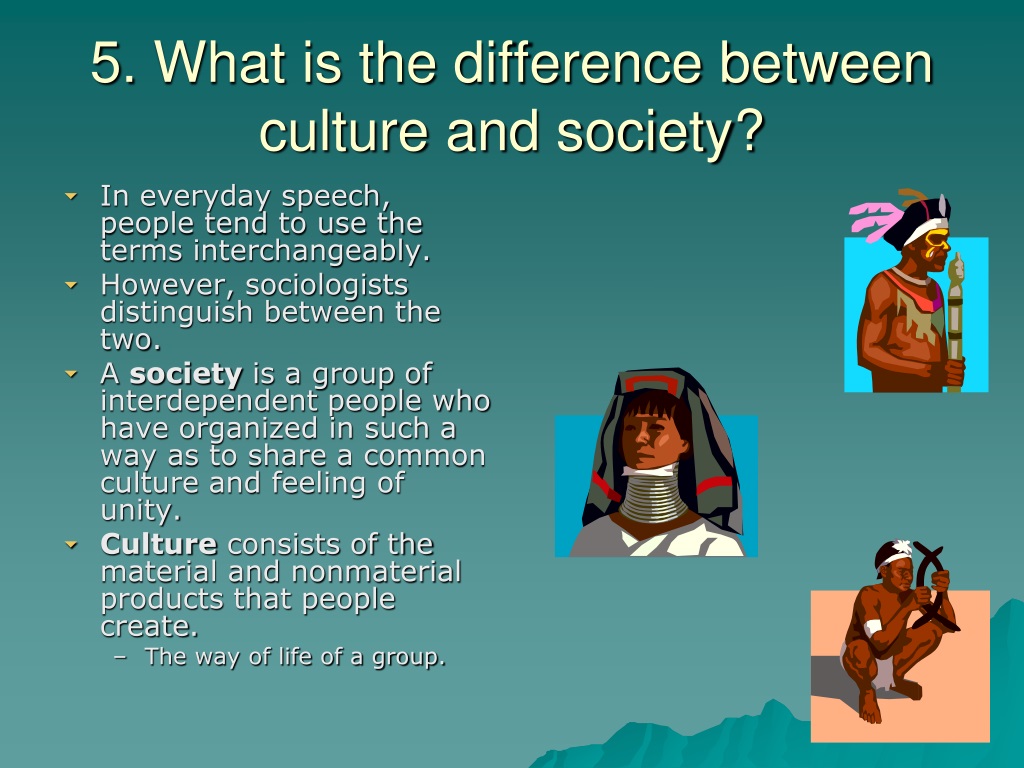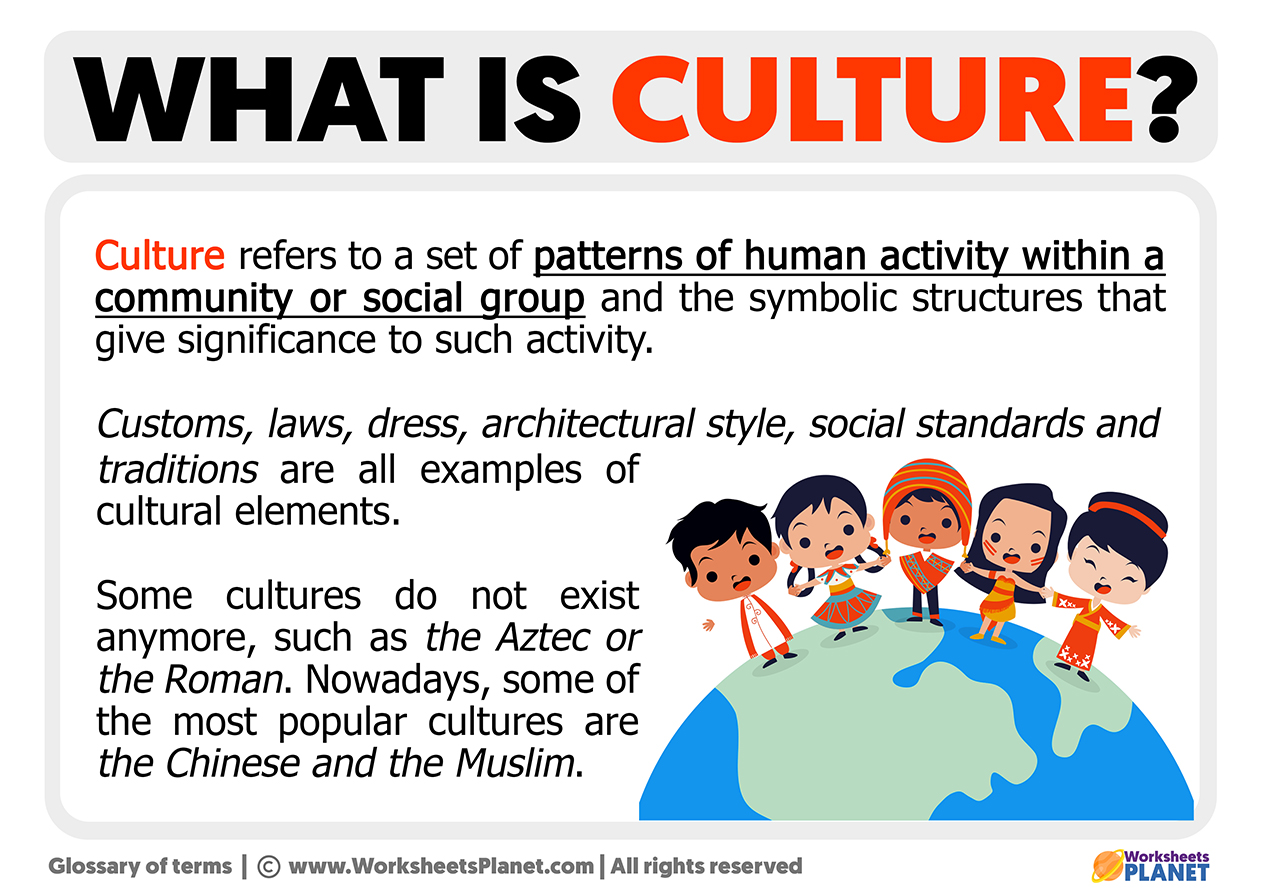Imagine walking into a bustling marketplace in Marrakech, the air thick with the aroma of spices and the cacophony of vendors hawking their wares. Or perhaps you’re at a quiet tea ceremony in Kyoto, the participants moving with a serene stillness as they savor the delicate flavors. Each of these experiences, though vastly different, embodies the essence of culture, a concept that shapes our lives, our interactions, and our very understanding of the world. But what exactly is culture, and how does it play out in the grand tapestry of human society? This is where sociology, the study of human behavior and social relationships, offers illuminating insights.

Image: www.slideserve.com
Culture, in its simplest terms, is the shared beliefs, customs, practices, and values that define a particular group of people. It’s a powerful force that binds us together, provides meaning to our lives, and shapes our individual identities. But culture is not static; it’s a dynamic entity constantly evolving in response to social, political, and economic changes. In this exploration, we’ll delve into the fascinating world of culture, unraveling its intricate threads and discovering how it shapes our lives and interactions.
The Building Blocks of Culture: A Symphony of Symbols
Like a symphony composed of intricate melodies, culture is built upon a foundation of symbols, language, norms, and values. Let’s dissect these fundamental elements to understand how they create the tapestry of culture:
Symbols: The Silent Language of Culture
Symbols, those powerful signifiers that transcend spoken words, carry a rich tapestry of meanings within a culture. The American flag, for example, evokes feelings of patriotism and national pride for many Americans. Similarly, the crescent moon and star symbolize Islam and represent a profound faith for millions across the globe. Symbols are not merely objects but gateways to understanding the shared values and beliefs of a community.
Language: Shaping Thoughts and Interactions
Language, the foundation of human communication, is a cornerstone of culture. It’s more than just words; it’s a system of shared meanings that allows us to understand each other, express ourselves, and transmit knowledge across generations. The language we speak, the idioms we use, and the stories we tell all contribute to the unique cultural identity of a group.

Image: www.worksheetsplanet.com
Norms: Navigating the Social Landscape
Norms, the unwritten rules of behavior, guide our interactions within a culture. They provide structure and predictability to our social lives, telling us what is acceptable and expected in different situations. Consider the norm of shaking hands as a greeting in many Western cultures, or the practice of bowing in Japan. These seemingly insignificant actions reveal the intricate web of social expectations that shape our daily lives.
Values: Guiding Principles of a Culture
Values, the moral principles and beliefs that guide our actions, serve as the compass for a culture. They define what is considered right and wrong, good and bad, and influence our choices, priorities, and ultimately, how we live. For instance, the value of individualism in American culture fosters a sense of self-reliance and personal achievement, while collectivism in many Asian cultures prioritizes group harmony and interdependence.
The Many Layers of Culture: From the Micro to the Macro
Culture is not a monolithic entity; it exists at multiple levels, from the intimate relationships within families to the vast global systems that connect us all.
Material Culture: The Tangible Expression of Values
Material culture refers to the tangible objects that embody a culture’s values and beliefs. From the architectural styles of homes to the clothes we wear, the tools we use, and the art we create, material culture offers a glimpse into the shared experiences and priorities of a community.
Nonmaterial Culture: The Unspoken Truths and Values
Nonmaterial culture encompasses the intangible aspects of a culture, including beliefs, values, attitudes, and behaviors. These invisible forces, often passed down through generations, shape our worldview and influence our social interactions.
Cultures in Dialogue: The Dance of Interplay and Change
Culture is not static; it’s a dynamic entity constantly evolving in response to interactions with other cultures. Through globalization, migration, and the rise of technology, cultures are increasingly intertwined, leading to a fascinating dance of interplay and change.
Cultural Diffusion: Sharing Ideas and Practices
Cultural diffusion refers to the spread of ideas, practices, and beliefs from one culture to another. From the global popularity of fast food chains to the adoption of online platforms for communication, cultural diffusion reshapes societies around the world.
Cultural Adaptation: Blending and Reinterpreting Traditions
As cultures encounter each other, they adapt and blend, creating new forms of cultural expression. This can manifest in diverse ways, from fusion cuisine that blends culinary traditions to the creation of new artistic forms that incorporate elements from different cultural backgrounds.
Culture in Action: Understanding Social Life
Culture is not just an abstract concept; it’s a powerful force that shapes every aspect of social life.
Social Groups: Sharing a Collective Identity
Culture plays a key role in defining social groups, from families and friend circles to religious communities and professional organizations. Shared beliefs, values, and practices create a sense of belonging and foster a collective identity among members.
Socialization: Learning the Ropes of Culture
Socialization, the process of learning the norms, values, and behaviors of a culture, begins at birth and continues throughout our lives. It’s through socialization that we acquire the skills and knowledge necessary to navigate our social world.
Social Institutions: Reflecting Cultural Values
Social institutions, such as family, education, religion, and government, are shaped by the cultural values of a society. They serve as the primary mechanisms for transmitting cultural knowledge and shaping individual behaviors.
The Power of Culture: Shaping Our Perceptions
Culture is not just about rituals and customs; it shapes our perceptions of the world around us.
Ethnocentrism: Viewing the World Through Our Cultural Lens
Ethnocentrism, the tendency to view one’s own culture as superior and to judge other cultures by its standards, can lead to prejudice and discrimination. It’s crucial to recognize our own cultural biases and to strive for a more nuanced understanding of other cultures.
Cultural Relativism: Embracing Diversity and Understanding
Cultural relativism encourages us to understand cultures within their own contexts, recognizing that no single culture is inherently superior to another. This perspective helps us appreciate the diversity of human experience and to avoid making hasty judgments based on our own cultural norms.
Applying Cultural Insights: Navigating a Diverse World
Understanding culture is not merely an academic exercise; it’s a vital skill for navigating our increasingly interconnected world.
Developing Cultural Competence: Respect and Empathy in Action
Cultural competence refers to the ability to interact effectively with people from diverse cultural backgrounds. This involves developing an awareness of one’s own cultural biases, fostering empathy for other cultures, and adapting communication styles to different contexts.
Building Bridges: Promoting Understanding and Collaboration
By embracing diversity and fostering a culture of inclusivity, we can bridge cultural divides, promote understanding, and create a more harmonious and equitable society.
The Future of Culture: A Continuous Evolution
Culture is a dynamic entity, constantly evolving in response to changing social, economic, and technological forces. It’s a testament to human ingenuity and creativity, and it will continue to shape our lives and interactions for generations to come.
What Is Culture In Sociology
Final Thoughts: Embracing the Tapestry of Culture
Culture defines who we are, how we interact with the world, and how we understand our place within it. It’s a complex and multifaceted concept, woven together by symbols, language, norms, and values. Embracing the richness and diversity of cultures is essential for building a more inclusive and harmonious world. As we navigate the intricate tapestry of human experience, let’s strive to understand, appreciate, and celebrate the unique beauty of each cultural thread.






